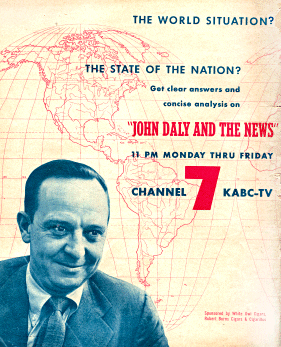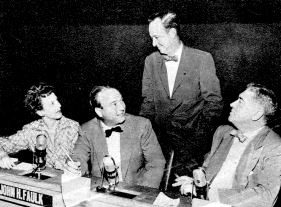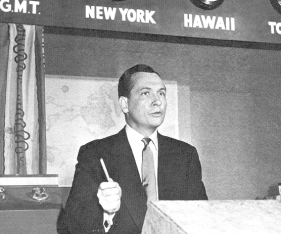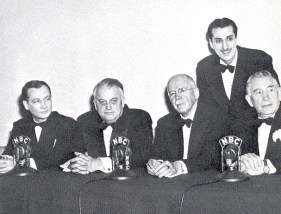Metropolitan
News-Enterprise
Thursday, February 13, 2003
Page 14
REMINISCING (Column)
TV Anchors Host Game Shows
By ROGER M. GRACE
Have you heard that Tom Brokaw and Dan Rather are each
taking on additional chores at their respective networks
by becoming hosts of game shows?
Yes, I’m joshing.
That the likes of Brokaw or Rather would participate in
such frivolity would be unthinkable. Yet, in earlier
days of television, network anchors and reporters were,
indeed, hosts and panelists on game shows.
John Charles Daly
was a CBS radio newscaster in the 1940s. It was he who
announced to the American public the bombing of Pearl
Harbor, breaking into CBS’ programming at
2:22
p.m., Eastern Time. He became a war correspondent, reporting
from
Europe.
From 1950-67, Daly was host of CBS television’s highly
popular “What’s My Line?” (heard on CBS radio from
1952-53). He was by then known simply as John Daly, though
the perennial panelist who introduced him, Random House
publisher Bennett Cerf, included his middle name.
Panelists would try to guess what the contestant did for a
living. There was at least one mystery guest, a celebrity
whose identity was the subject of the questioning by
blindfolded panelists.
Re-runs of the show are aired in the wee hours of the
morning on the Game Show Network (on “Black and White
Overnight,” featuring three vintage quiz shows, originally
a half-hour each, now collectively comprising two hours,
being padded with commercials and promos).
My daughter happened upon “What’s My Line” not long ago
and was fascinated to see a game show in quite an
unfamiliar form. Panelists and the host were in black tie,
conducting themselves with formality and civility.
A contestant on the show would be asked to “sign in,
please,” writing his or her name on a blackboard, and was
then introduced to the panel. Daly would pull out a chair
for a female contestant. The contestant, when exiting,
would shake hands with the panelists. “Mr. Daly” referred
to “Mr. Cerf” and to “Miss Dorothy” (later “Miss
Killgallen) and “Miss [Arlene] Francis.”
What was astounding about Daly’s weekly appearances on
CBS’s “What’s My Line” was that as of 1953, he was no
longer a part of CBS’s news team but was, rather, the
anchor of rival ABC’s nightly report, a role he played
until 1960. More than that, he was ABC’s vice president in
charge of news.
I remember a show aired right before the national
conventions of the major political parties got under way.
The mystery guests were the CBS reporters who were about
to cover those confabs. After the questioning ended, as I
recall, Daly made some gracious comment about CBS’
journalistic cadre, and made an oblique reference to his
being somewhere else during the conventions. Checking on
the Internet, I find that the show was aired Aug. 12,
1956. The CBS newsmen were anchor Douglas Edwards and
correspondents Charles Collingwood, Walter Cronkite, Eric
Sevareid, and Robert Trout. The Democratic National
Convention started the next day.
Far less remembered or successful than “What’s My Line?”
was a panel game show from the same producers, Mark
Goodson and Bill Todman, called “It’s News to Me.”
(Goodson and Todman spawned several other live
guessing-game shows, including “I’ve Got a Secret” and
“The Name’s the Same.”) “It’s News to Me” was aired on CBS
from 1951-53, then revived as a summer replacement in
July-August, 1954. Daly was host during the initial run.
Panelists tried to figure out from a clue what recent news
story the producers had in mind.
One of the regular panelists the first year was radio
commentator Quincy Howe.
The host of “It’s News to Me” during its 1954 summer
reprise was Walter Cronkite.
John Cameron Swayze
covered the Republican and Democratic national conventions
for NBC television in 1948 and the next year became the
network’s first news anchor, on “Camel News Caravan.” He
served in that capacity until 1956, and later performed
news chores on ABC news from 1960-62.
Swayze, like Daly, Howe, and Cronkite, had experience on
quiz shows. In 1947, then working for NBC radio, he
devised and emceed a quiz show called “Who Said That?”
with panelists seeking to identify the originator of a
famous quote.
The show went to NBC television, with CBS radio
correspondent Robert Trout serving as the first TV emcee,
from 1948-51, and Swayze, during that period, playing the
role of a panelist.
He was a panelist on the first episode of Goodman-Todson’s
CBS game show “To Tell the Truth” (on Dec. 18, 1956) and
was a frequent panelist after that, assuming the role of
substitute host on at least one occasion when Bud Collyer
was absent.
For a couple on months in 1958, he hosted a show on ABC on
which a panel of experts tried to hook up compatible
singles of opposite gender in the audience. It was called
“Chance of a Lifetime.”
More about newsmen who were game show hosts next
week.
Copyright 2003, Metropolitan News Company



